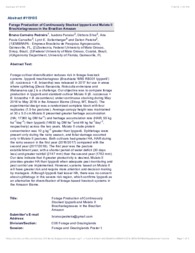Forage production of continuously stocked ipyporã and mulato II brachiariagrasses in the brazilian amazon.
Forage production of continuously stocked ipyporã and mulato II brachiariagrasses in the brazilian amazon.
Author(s): PEDREIRA, B. C. e; PARAISO, I.; SILVA, D.; CARVALHO, A. P.; SOLLENBERGER, L. E.; PEREIRA, D.
Summary: Forage cultivar diversification reduces risk in forage-livestock systems. Ipyporã brachiariagrass (Brachiaria 'BRS RB331 Ipyporã') (B. ruziziensis × B. brizantha) was released in 2017 for use in areas where spittlebug [Deois flavopicta, Notozulia entreriana and Mahanarva spp.] is a challenge. Our objective was to compare forage production in Ipyporã and standard cultivar Mulato II (B. ruziziensis × B. brizantha × B. decumbens) under continuous stocking during May 2016 to May 2018 in the Amazon Biome (Sinop, MT, Brazil). The experimental design was a randomized complete block with four replicates (1.5-ha pastures). Average canopy height was maintained at 30 ± 5.0 cm.Mulato II presented greater herbage accumulation (HA; 17360 kg DM ha-1) and herbage accumulation rate (HAR; 55 kg ha-1day-1) than Ipyporã (14930 kg DM ha-1and 48 kg ha-1day-1, respectively) across the two years. Mulato II crude protein concentration was 10 g kg-1 greater than Ipyporã. Spittlebugs were present only during the rainy season, and foliar damage occurred only in Mulato II pastures. Both cultivars had greater HA, HAR during the rainy season in the first year (2016/2017) compared with the second year (2017/2018). The first year was the pasture establishment year, with a shorter period of water deficit (30 days less) and greater rainfall (2147 mm) than the second year (1762 mm). Our data indicate that if greater productivity is desired, Mulato II provides greater HA than Ipyporã when adequate pest monitoring and pest control are implemented. However, systems based on Mulato II will have greater risk and require more attention and decision making by managers. Although Ipyporã had lesser HA, there was no concern about spittlebugs in this severe risk region, which confirms Ipyporã as an alternative for diversification of forage-based livestock systems in the Amazon Biome.
Publication year: 2019
Types of publication: Abstract in annals or event proceedings
Keywords: BRS RB331, Forage, Ipyporã, Mato Grosso, Mulato II, Sinop-MT, Urochloa brizantha
Observation
Some of Embrapa's publications are published as ePub files. To read them, use or download one of the following free software options to your computer or mobile device. Android: Google Play Books; IOS: iBooks; Windows and Linux: Calibre.
Access other publications
Access the Agricultural Research Database (BDPA) to consult Embrapa's full library collection and records.
Visit Embrapa Bookstore to purchase books and other publications sold by Embrapa.

